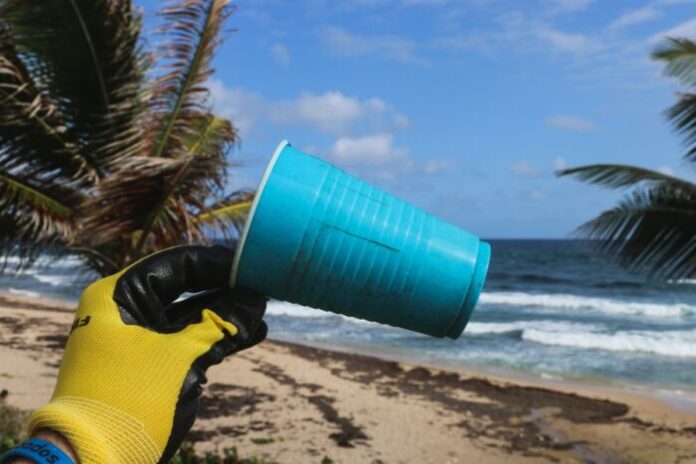
“Microplastics are a global phenomenon that can’t be adequately understood or addressed in the context of the marine environment alone,” says Professor Rob Hale of William & Mary’s Virginia Institute of Marine Science, VIMS. “Plastics are produced, used, and discarded on land, and disperse through soils, rivers, and the atmosphere. The cat’s already out of the bag if you’re talking about dealing with these materials after they’ve reached the ocean.”
Professor Hale is lead author of a new “Grand Challenges” paper commissioned to mark the 100th anniversary of the American Geophysical Union, the world’s largest association of Earth and space scientists with more than 60,000 members in 137 countries.
The paper, “A Global Perspective on Microplastics,” published in the January issue of the “Journal of Geophysical Research: Oceans,” is co-authored by VIMS doctoral student Meredith Seeley and senior research scientist Dr. Mark LaGuardia, along with Drs. Lei Mai and Eddy Zeng of Jinan University in Guangzhou, China.
Used in manufacturing, industry, and 3D printing, microplastics are manufactured for consumer products such as synthetic fabric, toothpaste, and cosmetics, and they also are formed when larger plastics break apart into tiny beads.
When microplastics wash down a drain, they are not removed by wastewater treatment and create problems in the environment. Microplastics are now found everywhere in the ocean and coastal waters, shorelines, ocean seabed, and sea surfaces. There has been widespread concern among scientists and the public that these minute synthetic fragments are impacting marine ecosystems.
“It’s not just an ocean problem,” says Professor Hale. “There’s growing evidence that microplastics are distributed across the land surface and in the air.” Wind plays a role in carrying microplastics to the streets of European cities and remote areas of the Arctic Ocean, where ecosystems are already stressed by the effects of climate change.
And the VIMS researchers note that the global scope of the microplastics issue extends to the social sphere as well. “We have to recognize that microplastic pollution is an international problem that doesn’t respect political boundaries,” says Seeley. “As with climate change and species management, developed and emerging nations will have to cooperate to find equitable solutions.”
Major sources of microplastics include agricultural runoff, aquaculture, cruise ships, ocean dumping, stormwater, the shipping and fishing industries, urban runoff and waste management. Microfibers shed from synthetic clothing and fishing nets are a form of microplastic.
These fibers, beads, and microplastic fragments can all absorb harmful pollutants like pesticides, dyes, and flame retardants, only to later release them in the ocean. Scientists have even found microplastic particles in rain.
Plastic” is a catch-all term for a complex array of materials that vary in chemical composition, size, texture, and shape. Plastics are often infused with additives, including flame retardants and UV inhibitors, which may themselves have environmental and health impacts.
“People often assume that all plastics are the same and behave identically in the environment,” says Hale, “but that isn’t the case at all. To resolve key questions and mitigate possible impacts, everyone – manufacturers, scientists, health-care specialists, engineers, economists, policymakers, and others – must collaborate to better understand the composition and nature of plastic products and their additives.”
The VIMS researchers stress that the characteristics of microplastics can and do change during and after use. “The complexity of microplastics becomes even more convoluted once they enter the environment and begin to intermingle and weather,” says LaGuardia. “We have to better understand these complexities, especially in transition zones such as estuaries.”
The VIMS authors’ concerns regarding microplastics extend to potential impacts on human health. “There have been concerns about ingesting microplastics from seafood, but the indoor environment is our biggest direct threat,” says Hale. “Many people in developed countries spend almost all their time indoors, in spaces that are increasingly air-tight and insulated with things like polystyrene foam. Our exposure to microplastics from breathing and ingesting indoor dust may have toxicological consequences, but there’s been very little research.”



































